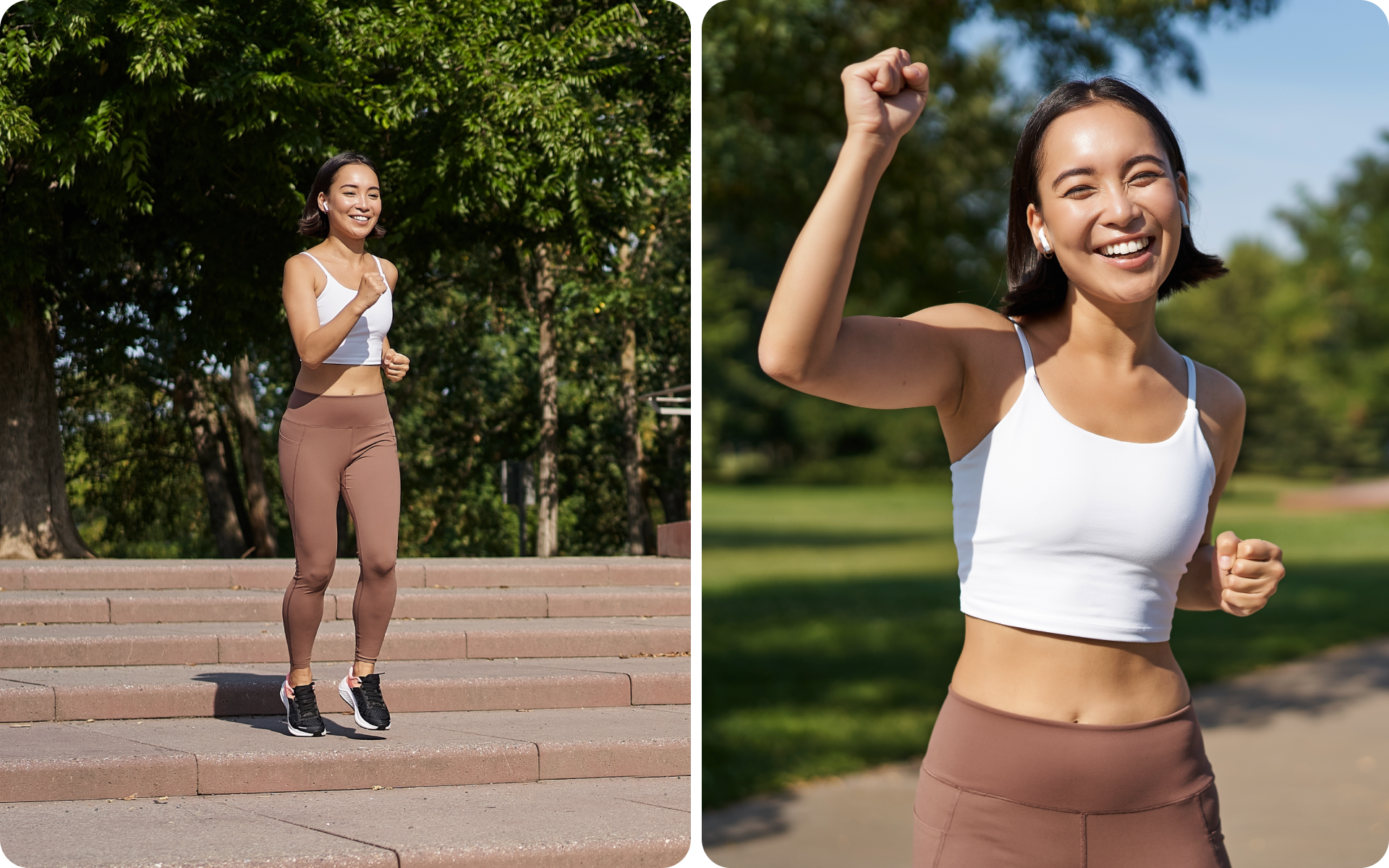When we think about easy workout routines, activities such as jumping rope and running are what most people tend to think about, especially when money is tight and they don’t have tons of cash to spend on a fancy gym pass to shed those extra pounds and sculpt the body of their dreams.
While these are great options, a busy schedule or a simple lack of motivation can make you fall off your routine and never achieve your goals. This is where walking comes in. By simply relying on an activity we do every day, you can increase your chances of not only following through with your workout plan but also sculpting that body you desire.
But how do you make a walking plan to lose weight? Are there some tips and tricks you can use to ensure fantastic results? How much do you need to walk to finally lose weight? Read on to find out all of this and more.
What Are the Health Benefits of Walking?
Most people walk every day. It’s a subconscious activity we do without ever having to think about it as it’s so ingrained into our day-to-day lives. Due to technological advancements and how our societies are set up, many of us don’t get to walk as much as we used to, which is something we ought to change. Here are some health-related reasons to encourage you to do a bit more walking in your everyday life.
Can Reduce Stress and Improve Your Mood
Unfortunately, stress is a part of everyday life. In most cases, stressful situations pass after a short while and we can all go back to normal. However, in other cases, the stress lasts for a while and becomes chronic stress, a condition that has been linked to issues such as brain function complications, memory loss, reduced cognition and learning ability, impaired immune function, and gastrointestinal complications. (1)
Fortunately, walking, especially in nature, can help combat the negative side effects of stress. In one study published in 2018, researchers found that when students who were stressed from studying during their exam period walked in nature, their cortisol levels were lower and their moods improved significantly (1).
In another study published in the International Journal of Environmental Research and Public Health, researchers looking at the autonomic nervous system responses of test subjects walking in nature found this activity to help reduce their negative moods and increase their positive mood parameters (2). This shows that walking in nature has positive psychological benefits for anyone who partakes.
Can Improve Your Brain and Emotional Health
According to the World Health Organisation, 15 million people worldwide suffer from stroke annually, 5 million of whom lose their lives and another 5 million are left permanently disabled (3). While strokes generally occur in people aged 65 and above, the CDC warns that people of any age can suffer from them (4).
Walking is one thing that can help reduce your chances of being a part of these statistics. A study published in 2019 showed walking can help reduce stroke events in both men and women. The research also showed that both slow and fast walking had preventative effects on this illness, but the best results were seen in fast walkers who experienced a 44% lower risk of stroke (5).
Research has also shown that by simply walking, you can reduce the risk of Alzheimer’s and other kinds of dementia (6). This is particularly important for older adults who are the most affected by these kinds of neurological illnesses.
Studies have also shown that this activity has a positive impact on people’s emotional health, which plays an important role in regulating their mental health (7). Long-distance walking specifically has been shown to positively impact mental health, particularly regarding the regulation of emotional distress. Therefore, walking 4 miles a day could be beneficial for weight loss and your mental health (8).
Yanking yourself back in shape has never been so easy with our game-changing fitness app! Start transforming your life with BetterMe!
Stronger Bones
Bad or weak bone health is associated with issues such as osteoporosis, loss of height, back pain, stooped posture, and an increased risk of fractures (9). Lifestyle factors such as diet and increased physical activity are two main factors that can help boost your bone mass, which increases bone health (10). Research has shown that walking is one of the easiest and most effective ways to improve bone health (11, 12, 13).
Weight Loss
Studies continue to prove that walking can help with weight loss.
- A study comparing energy expenditure in adult normal-weight walkers, overweight walkers, and marathon runners found that all groups burned a relatively similar number of calories when walking or running a mile.
This helped researchers conclude that walking is an excellent physical activity for calorie-burning in overweight individuals who are capable of walking without predisposed conditions such as osteoarthritis or cardiovascular risk factors (14).
- Another study also examined the calorie-burning effects of walking versus running in people with average fitness levels, and it was found that both activities help burn a lot of calories. While running had higher calorie-burning results, researchers recommended that either activity was useful for increasing energy expenditure, which helps with weight loss (15).
- In a study published in the Risk Analysis journal, researchers stated that people who walk at a brisk or fast pace are more likely to have a lower weight compared to individuals who perform other activities (16).
Read more: Indoor Walking Workout for Beginners When It’s Too Cold To Walk Outside
Useful Tips for Walking for Weight Loss
Clearly, walking is remarkably beneficial for your health. However, for many, the pounds won’t disappear if you simply walk to your job and back. Here are some things you can do to ensure that following BetterMe walking plan for weight loss will give you the results you want
Familiarize Yourself with Different Kinds of Walking
Walking is simple enough and you can lose weight performing this activity without knowing all the varieties of walking. However, learning different types of walking styles and how to use them can help push your walking plan for weight loss to a whole new level.
For example, some walking styles are better suited for the city while others are better used in the wilderness and cross country. Brisk walking and power walking may seem like the same thing but they’re not. Nordic walking benefits are extensive but this activity doesn’t work well in the city and it requires both a specialized technique and equipment to do it correctly.
Knowing all different kinds of walking styles will make walking that much more interesting, help build your social circle, and get you into new hobbies.
Increase Your Pace
There’s nothing wrong with walking at a casual pace as your form of exercise for weight loss. However, if you want to increase your total calories burned, increasing your pace could be the answer you’re looking for. A faster pace means you have to use more energy, which translates to more calorie burning. This ultimately means faster weight loss when combined with proper eating habits. You could also alternate between fast and slow-paced walking. Perhaps you start off fast and then start to get tired, so you slow things down. This is a great way to gradually increase your walking pace over time.
Read more: The 28-Day Indoor Walking Weight Loss Challenge Explained
Walk for Longer Periods
If walking faster is out of the question due to health or joint issues, then walking for longer is what you may need. In a study published in 2022, researchers comparing weight loss in slow versus fast walkers found overweight subjects who walked at a slower pace but for longer periods of time lost more weight than fast walkers who walked for shorter periods (19).
Walk at an Incline
A study published in the Physical Activity and Nutrition journal found that women walking at a 6% gradient on a treadmill had more energy expenditure and fat oxidation than women who walked on a 0% gradient (20).
If you’re walking indoors using a treadmill, you could put it on an incline. If you’re using a walking pad, look to see if it comes with an adjustable incline and make use of it. If you’re walking outdoors, look for hills or try walking in areas that have a lot of stairs.
BetterMe Walking Plan: Make Use of Exercise Accessories
Accessories such as resistance bands and weighted vests add resistance to your walking workout, which can help with increased calorie-burning. Ankle weights can also be a good addition (21, 22), but make sure not to overuse them as some people have warned that they may lead to some undesirable side effects (23).
Increase Your Steps
This is the simplest way to lose weight. Research has shown that by walking the popular 10,000 steps a day, you’ll be able to lose weight and improve your mental health (24). If you can go above 10k steps a day, even better – just make sure not to overdo it. However, if your daily step average is well below 10k, you should aim for a goal that suits your individual abilities. Say you typically walk 3k steps in a day, try to stretch it out to 5k as the jump from 3k to 5k is far less than 3k to 10k. This can help make your walking plan feel much more attainable and help you stay consistent with it.
If you wish to cinch your waist, tone up your bat wings, blast away the muffin top – our fitness app was created to cater to all your needs! BetterMe won’t give excess weight a chance!
The Ultimate BetterMe Walking Plan to Lose Weight
You can interchange the days as you wish and break the walks into smaller parts if you don’t have enough time for a long one. Here’s a sample plan, but feel free to modify the times as you see fit:
- Sunday: Perform a long walking workout, 60 minutes of brisk walking.
- Monday: You can simply stroll, but there is no workout on this day.
- Tuesday: A short workout with only 30 minutes of brisk walking. You may also include strength training on this day.
- Wednesday: Short, 30-minute brisk walk.
- Thursday: Long, 60-minute brisk walk.
- Friday: Short 30 minutes of brisk walking plus strength training.
- Saturday: Long, easy walking day with 30 minutes of brisk walking, then 30 to 90 more minutes at an easy pace.
FAQs
How much do I need to walk to lose weight?
As previously stated, research suggests that walking 10k steps a day is ideal for weight loss, so it would be best to aim for this number (24). If you can’t achieve this in the beginning, don’t feel frustrated. Simply start slow and work up to 10k. Remember to focus on goals that will work for you. The best workout plan is one you believe you can accomplish consistently and for a long period of time.
For those who can easily reach 10k and feel like they can do more, feel free to go further. As long as it feels manageable to you, it’s fine to push yourself as much as you can.
Can I burn belly fat by walking?
Yes, you can burn fat when you combine walking with proper eating habits. Research over the years on different demographics has shown that walking can help reduce BMI, body fat, and waist circumference, among other benefits (25, 26, 27).
How many steps to lose 10 lbs in 1 month?
In order to lose this much weight in a month, you need to be in a calorie deficit where you consume less calories than you burn each day. But losing 10lbs in 1 month is most likely not healthy, so you should keep your expectations realistic. Research has shown that the largest amount of weight you can lose in a month is approximately 8 lbs, at a rate of 1 to 2 pounds a week (28).
Is it better to walk falk Faster or longer to lose weight?
Both options are good, but walking for longer seems to produce better fat loss results (19).
Should you eat before or after walking to lose weight?
This depends on your preference. Some people prefer to work out in a fasted state, while others find it better to have something small in their stomachs before they work out. Play around with either option to find out which works best for you.
The Bottom Line
The trick to a good walking plan to lose weight is finding what works for you and being consistent with it. Above all, don’t forget to hydrate and always eat healthy meals at a calorie deficit.
DISCLAIMER:
This article is intended for general informational purposes only and does not serve to address individual circumstances. It is not a substitute for professional advice or help and should not be relied on for making any kind of decision-making. Any action taken as a direct or indirect result of the information in this article is entirely at your own risk and is your sole responsibility.
BetterMe, its content staff, and its medical advisors accept no responsibility for inaccuracies, errors, misstatements, inconsistencies, or omissions and specifically disclaim any liability, loss or risk, personal, professional or otherwise, which may be incurred as a consequence, directly or indirectly, of the use and/or application of any content.
You should always seek the advice of your physician or other qualified health provider with any questions you may have regarding a medical condition or your specific situation. Never disregard professional medical advice or delay seeking it because of BetterMe content. If you suspect or think you may have a medical emergency, call your doctor.
SOURCES
- Health Benefits of Walking in Nature: A Randomized Controlled Study Under Conditions of Real-Life Stress (2018, journals.sagepub.com)
- Assessing the Effects of Nature on Physiological States Using Wearable Technologies (2022, ncbi.nlm.nih.gov)
- Stroke, Cerebrovascular accident (n.d., researchgate.net)
- Stroke Facts (2024, cdc.gov)
- Walking pace and the risk of stroke: A meta-analysis of prospective cohort studies (2019, researchgate.net)
- Keep on Walking (2015, ncbi.nlm.nih.gov)
- Exploring the Relationship between Walking and Emotional Health in China (2020, ncbi.nlm.nih.gov)
- Are Long-Distance Walks Therapeutic? A Systematic Scoping Review of the Conceptualization of Long-Distance Walking and Its Relation to Mental Health (2021, ncbi.nlm.nih.gov)
- Bone Health and Osteoporosis: What It Means to You (2019, niams.nih.gov)
- Determinants of Bone Health (n.d., ncbi.nlm.nih.gov)
- Walking is related to bone density and rates of bone loss (1994, sciencedirect.com)
- Leisure-Time Physical Activity and Risk of Fracture: A Cohort Study of 66,940 Men and Women (2017, onlinelibrary.wiley.com)
- Evidence on physical activity and osteoporosis prevention for people aged 65+ years: a systematic review to inform the WHO guidelines on physical activity and sedentary behaviour (2020, ijbnpa.biomedcentral.com)
- Comparison of energy expenditure to walk or run a mile in adult normal weight and overweight men and women (2010, pubmed.ncbi.nlm.nih.gov)
- Energy expenditure comparison between walking and running in average fitness individuals (2012, pubmed.ncbi.nlm.nih.gov)
- Do All Activities “Weigh” Equally? How Different Physical Activities Differ as Predictors of Weight (2015, onlinelibrary.wiley.com)
- The multifaceted benefits of walking for healthy aging: from Blue Zones to molecular mechanisms (2023, link.springer.com)
- Is there evidence that walking groups have health benefits? A systematic review and meta-analysis (2015, bjsm.bmj.com)
- Effects of Walking Speed on Total and Regional Body Fat in Healthy Postmenopausal Women (2022, pubmed.ncbi.nlm.nih.gov)
- Effects of gradient and age on energy expenditure and fat metabolism during aerobic exercise at equal intensity in women (2022, ncbi.nlm.nih.gov)
- The effects of ankle weight loading on the walking factors of adults without symptoms (2017, ncbi.nlm.nih.gov)
- To Compare the Effects of Adding Handheld and Ankle Weights During Treadmill Walking on Blood Pressure and Rate of Perceived Exertion in Normal Healthy Adults: An Experimental Study (2023, journals.lww.com)
- Wearable weights: How they can help or hurt (2021, health.harvard.edu)
- Effects of 10,000 steps a day on physical and mental health in overweight participants in a community setting: a preliminary study (2016, ncbi.nlm.nih.gov)
- Effect of walking exercise on abdominal fat, insulin resistance and serum cytokines in obese women (2014, ncbi.nlm.nih.gov)
- Walking as a feasible means of effecting positive changes in BMI, waist, and blood pressure in black South African women (2018, ncbi.nlm.nih.gov)
- [Effects of short-term intervention of walking on body mass index, waist circumference, and related indicators of working population] (2019, pubmed.ncbi.nlm.nih.gov)
- Steps for Losing Weight (2023, cdc.gov)

















